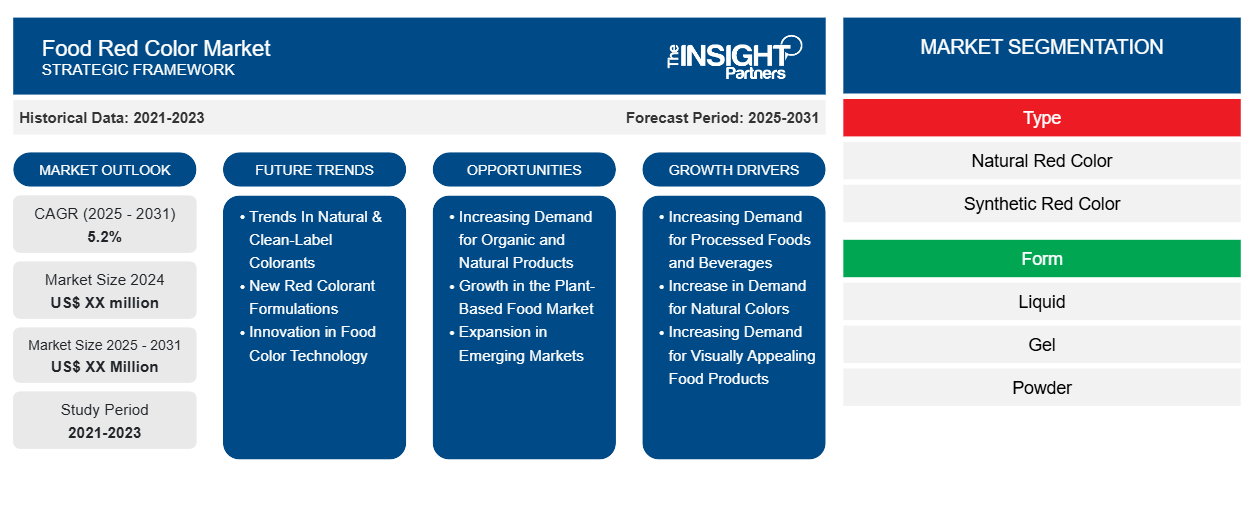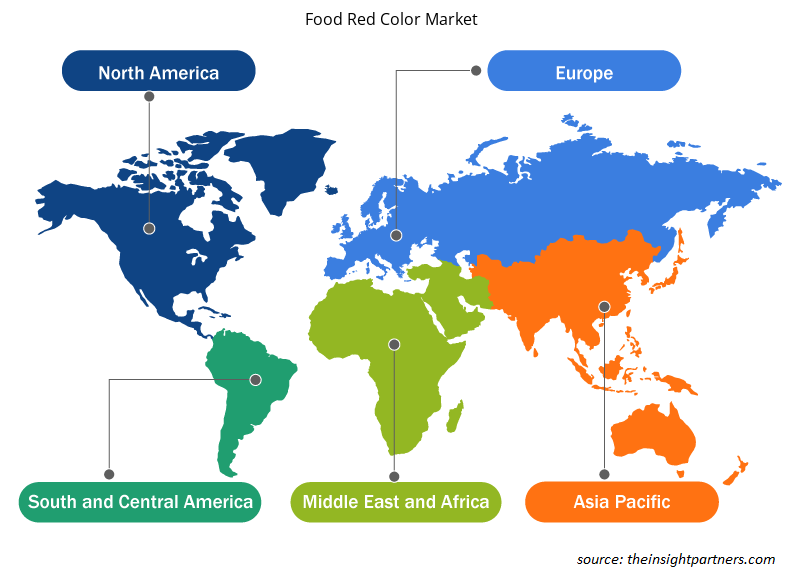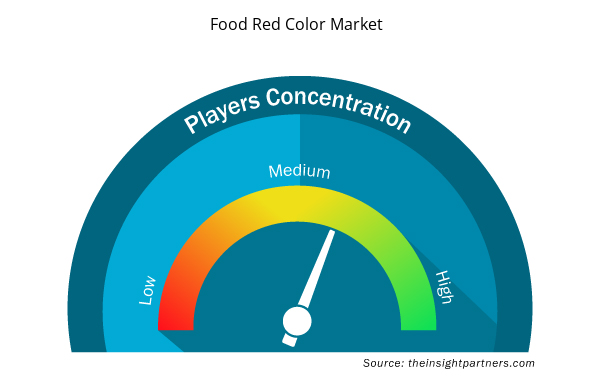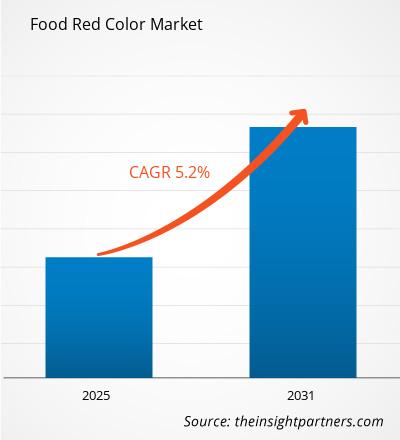The Food Red Color Market is expected to register a CAGR of 5.2% from 2025 to 2031, with a market size expanding from US$ XX million in 2024 to US$ XX Million by 2031.
The Food Red Color Market is classified by type into Natural Red Color and Synthetic Red Color, and by form, i.e., Liquid, Gel, and Powder. It further explores applications such as Processed Food, Bakery and Confectionery Products, Meat Poultry and Seafood, Oils and Fats, Dairy Products, Juice and Juice Concentrates, Carbonated Soft Drinks, and Others. Forecasts through 2031 offer insights into how regulations and consumer preferences for natural colorants impact market growth and industry standards. The global analysis is broken down at the regional level and major countries. The market evaluation is presented in US$ for the above segmental analysis.
Purpose of the Report
The report Food Red Color Market by The Insight Partners aims to describe the present landscape and future growth, top driving factors, challenges, and opportunities. This will provide insights to various business stakeholders, such as:
- Technology Providers/Manufacturers: To understand the evolving market dynamics and know the potential growth opportunities, enabling them to make informed strategic decisions.
- Investors: To conduct a comprehensive trend analysis regarding the market growth rate, market financial projections, and opportunities that exist across the value chain.
- Regulatory bodies: To regulate policies and police activities in the market with the aim of minimizing abuse, preserving investor trust and confidence, and upholding the integrity and stability of the market.
Food Red Color Market Segmentation
Type
- Natural Red Color
- Synthetic Red Color
Form
- Liquid
- Gel
- Powder
Application
- Processed food
- Bakery and confectionery products
- Meat poultry and seafood
- Â Oils and fats
- Dairy products
- Juice and juice concentrates
- Carbonated soft drinks
- Others
Geography
- North America
- Europe
- Asia-Pacific
- South and Central America
- Middle East and Africa
Customize This Report To Suit Your Requirement
You will get customization on any report - free of charge - including parts of this report, or country-level analysis, Excel Data pack, as well as avail great offers and discounts for start-ups & universities
Food Red Color Market: Strategic Insights

- Get Top Key Market Trends of this report.This FREE sample will include data analysis, ranging from market trends to estimates and forecasts.
Food Red Color Market Growth Drivers
- Increasing Demand for Processed Foods and Beverages: Growing demand for appealing food products, especially in beverage and confectionery sectors, is driving food red colorants market for coloring drinks, candy, and packaged foods.
- Increase in Demand for Natural Colors: As consumers are buying more natural products, demand for natural red dyes like beetroot extract and hibiscus extract also grows, and manufacturers have stopped using synthetic red dyes and switched to natural alternatives.
- Increasing Demand for Visually Appealing Food Products: The main drivers of the food red color market are the increasing consumer demands for visually appealing and attractive food products. Red is perceived as appetizing, flavorful, and indulgent foods, which makes it the most popular choice in coloring products such as candies, beverages, cakes, and sauces. The aesthetic appeal of red-colored foods is quite imperative for the consumer purchase, particularly in the segments such as confectionery, beverages, and snacks.
Food Red Color Market Future Trends
- Trends In Natural & Clean-Label Colorants: As a part of the clean-label trend, people are starting to want red colorants that are not made from chemicals. That’s the trend that’s encouraging natural sources such as beet juice, paprika, and cochineal extract.
- New Red Colorant Formulations: Advancements in red dye extraction and compositions are helping producers to extend the stability, shelf life and heat resistance of red dyes so they can be employed in a greater number of foods.
- Innovation in Food Color Technology: The food colorant industry is witnessing research and development efforts that are bringing forth innovations that enhance the quality, stability, and efficiency of red colorants. Technological advancements have resulted in the development of more stable and long-lasting natural colorants that can withstand the rigors of food processing, including heat, light, and pH variations. This, together with meeting the high demand for natural plant-based colourants, will drive efforts to seek novel extraction methods of natural red pigments.
Food Red Color Market Opportunities
- Increasing Demand for Organic and Natural Products: As the organic and natural food industries are growing, there is great potential for the food red color market to grow by providing natural pigments for organic-certified products.
- Growth in the Plant-Based Food Market: Plant-based food is on the rise, this opens up the possibility of using plant-based red pigments to appeal to vegan and vegetarian diets, where natural components are needed more than ever.
- Expansion in Emerging Markets: The opportunities are huge for the food red color market in emerging markets, particularly in Asia-Pacific, Latin America, and the Middle East. With increases in disposable incomes and levels of urbanization, regions are showing higher consumption levels of processed and packaged foods, hence a greater need for food colorants. Companies can reach out to these emerging markets by launching affordable food color solutions, which will include both synthetic and natural red colorants, based on local consumer preferences.
Food Red Color Market Regional Insights
The regional trends and factors influencing the Food Red Color Market throughout the forecast period have been thoroughly explained by the analysts at Insight Partners. This section also discusses Food Red Color Market segments and geography across North America, Europe, Asia Pacific, Middle East and Africa, and South and Central America.

- Get the Regional Specific Data for Food Red Color Market
Food Red Color Market Report Scope
| Report Attribute | Details |
|---|---|
| Market size in 2024 | US$ XX million |
| Market Size by 2031 | US$ XX Million |
| Global CAGR (2025 - 2031) | 5.2% |
| Historical Data | 2021-2023 |
| Forecast period | 2025-2031 |
| Segments Covered |
By Type
|
| Regions and Countries Covered | North America
|
| Market leaders and key company profiles |
Food Red Color Market Players Density: Understanding Its Impact on Business Dynamics
The Food Red Color Market market is growing rapidly, driven by increasing end-user demand due to factors such as evolving consumer preferences, technological advancements, and greater awareness of the product's benefits. As demand rises, businesses are expanding their offerings, innovating to meet consumer needs, and capitalizing on emerging trends, which further fuels market growth.
Market players density refers to the distribution of firms or companies operating within a particular market or industry. It indicates how many competitors (market players) are present in a given market space relative to its size or total market value.
Major Companies operating in the Food Red Color Market are:
- ADM
- Chr. Hansen
- Dowdupont
- Sensient Technologies
- DSM
Disclaimer: The companies listed above are not ranked in any particular order.

- Get the Food Red Color Market top key players overview
Key Selling Points
- Comprehensive Coverage: The report comprehensively covers the analysis of products, services, types, and end users of the Food Red Color Market, providing a holistic landscape.
- Expert Analysis: The report is compiled based on the in-depth understanding of industry experts and analysts.
- Up-to-date Information: The report assures business relevance due to its coverage of recent information and data trends.
- Customization Options: This report can be customized to cater to specific client requirements and suit the business strategies aptly.
The research report on the Food Red Color Market can, therefore, help spearhead the trail of decoding and understanding the industry scenario and growth prospects. Although there can be a few valid concerns, the overall benefits of this report tend to outweigh the disadvantages.
- Historical Analysis (2 Years), Base Year, Forecast (7 Years) with CAGR
- PEST and SWOT Analysis
- Market Size Value / Volume - Global, Regional, Country
- Industry and Competitive Landscape
- Excel Dataset



Report Coverage
Revenue forecast, Company Analysis, Industry landscape, Growth factors, and Trends

Segment Covered
This text is related
to segments covered.

Regional Scope
North America, Europe, Asia Pacific, Middle East & Africa, South & Central America

Country Scope
This text is related
to country scope.
Frequently Asked Questions
Some of the customization options available based on request are additional 3-5 company profiles and country-specific analysis of 3-5 countries of your choice. Customizations are to be requested/discussed before making final order confirmation, as our team would review the same and check the feasibility.
The report can be delivered in PDF/PPT format; we can also share excel dataset based on the request.
Key companies in this market are- ADM, Chr. Hansen, Dowdupont, Sensient Technologies, DSM, Naturex, DDW, Döhler Group, Fiorio Colori,
The market is expected to register a CAGR of 5.2% during 2023-2031.
Future trends include an increasing demand for natural red colorants, innovations in extraction methods, and growing consumer preference for non-GMO and organic products.
The food red color market is driven by the demand for visually appealing foods, the growing preference for natural and plant-based colorants, and regulatory approvals for food-safe colorants.
Trends and growth analysis reports related to Food and Beverages : READ MORE..
1. ADM
2. Chr. Hansen
3. Dowdupont
4. Sensient Technologies
5. DSM
6. Naturex
7. DDW
8. Döhler Group
9. Fiorio Colori
10. Kalsec

 Get Free Sample For
Get Free Sample For